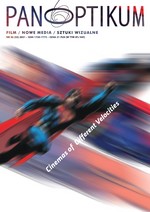Tachyons, tactility, drawing and withdrawing: cinema at the speed of darkness
Tachyons, tactility, drawing and withdrawing: cinema at the speed of darkness
Author(s): Wiliam BrownSubject(s): Film / Cinema / Cinematography
Published by: Uniwersytet Gdański
Keywords: speed cinema; tactility; darkness;
Summary/Abstract: Longitudinal, quantitative analyses of cinema have established how Hollywood is getting ‘quicker, faster, darker’. While in some senses the ‘intensified continuity’ of contemporary Hollywood narration is a given, the increased darkness of contemporary mainstream cinema remains unexplored – especially with regard to how its speed and its darkness might be inter-related. If to darken the majority of the screen during a film helps to draw our attention to the salient aspects of the image that are better illuminated, then of course this also allows for a faster cutting rate: in principle, there is ‘less’ information for the viewer to have to take in during each shot, meaning that the film can then cut to subsequent images more rapidly. However, there are other ways in which we can interpret this ‘darkening’ of contemporary film narration. For example, it perhaps ties in with a widespread sense of disorientation with regard to the increasingly globalized and connected world that digitization has helped to bring about, and which is equally reflected in the rise of the contemporary ‘mind-game’ or ‘puzzle’ film that is a staple of contemporary Hollywood. The darkness in such films thus gives expression to uncertainty and disorientation.
Journal: Panoptikum
- Issue Year: 2021
- Issue No: 26 (33)
- Page Range: 19-38
- Page Count: 20
- Language: English

